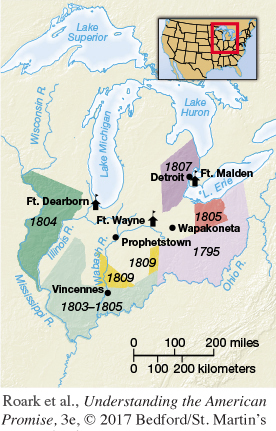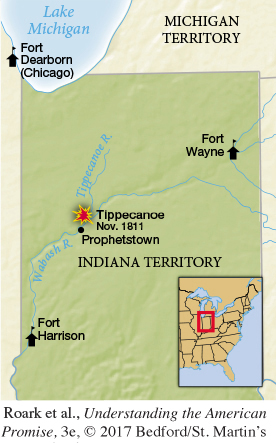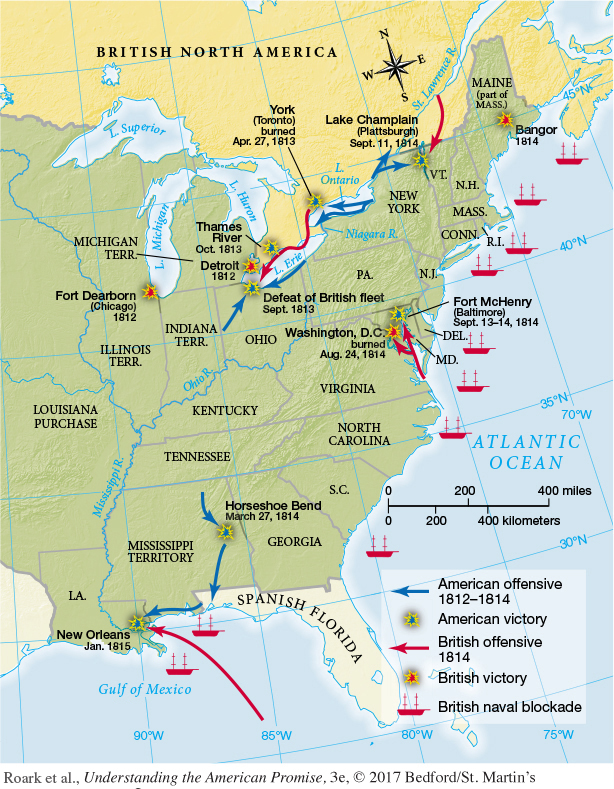Tecumseh and Tippecanoe
While the Madisons cemented alliances at home, difficulties with Britain and France overseas and with Indians in the old Northwest continued to increase. The Shawnee chief Tecumseh actively solidified his confederacy, while the more northern tribes renewed their ties with supportive British agents in Canada, a potential source of food and weapons. If the United States went to war with Britain, serious repercussions on the frontier would clearly follow.

Shifting demographics put the Indians under pressure. The 1810 census counted some 230,000 Americans in Ohio, while another 40,000 inhabited the territories of Indiana, Illinois, and Michigan. The Indian population of the same area was much smaller, probably about 70,000. [[LP Spot Map: SM10.02 Indian Lands Ceded in the Northwest Territory before 1810/
> UNDERSTAND
POINTS OF VIEW
Why did William Henry Harrison and his supporters find Tecumseh’s message so threatening?

Up to 1805, Indiana’s territorial governor, William Henry Harrison, had negotiated a series of treaties in a divide-and-conquer strategy aimed at extracting Indian lands for paltry payments. But with the rise to power of Tecumseh and his brother Tenskwatawa, the Prophet, Harrison’s strategy faltered. A fundamental part of Tecumseh’s message was the assertion that all Indian lands were held in common by all the tribes. “No tribe has the right to sell [these lands], even to each other, much less to strangers,” Tecumseh said. “Sell a country! Why not sell the air, the great sea, as well as the earth? Didn’t the Great Spirit make them all for the use of his children?” In 1809, while Tecumseh was away on a recruiting trip, Harrison assembled the leaders of the Potawatomi, Miami, and Delaware tribes to negotiate the Treaty of Fort Wayne. After promising (falsely) that this was the last cession of land the United States would seek, Harrison secured three million acres at about two cents per acre. [[LP Spot Map: SM10.03 Battle of Tippecanoe, 1811/
When he returned, Tecumseh was furious with both Harrison and the tribal leaders. Leaving his brother in charge at Prophetstown on the Tippecanoe River, the Shawnee chief left to seek alliances with tribes in the South. In November 1811, Harrison decided to attack Prophetstown with a thousand men. The two-hour battle resulted in the deaths of sixty-two Americans and forty Indians before the Prophet’s forces fled. The Americans won the battle of Tippecanoe, but Tecumseh was now more ready than ever to make war on the United States.
The Indian conflicts in the old Northwest soon merged into the wider conflict with Britain, now known as the War of 1812. Between 1809 and 1812, Madison teetered between declaring either Britain or France America’s primary enemy, as attacks by both countries on U.S. ships continued. In 1809, Congress replaced Jefferson’s embargo with the Non-Intercourse Act, which prohibited trade only with Britain and France and their colonies, thus opening up other trade routes to alleviate the economic distress of American shippers, farmers, and planters. By 1811, the country was seriously divided and on the verge of war.
The new Congress seated in March 1811 contained several dozen young Republicans from the West and South who would come to be known as the War Hawks. Led by thirty-four-year-old Henry Clay from Kentucky and twenty-nine-year-old John C. Calhoun from South Carolina, they welcomed a war with Britain both to justify attacks on the Indians and to bring an end to impressment. Many were also expansionists, looking to occupy Florida and threaten Canada. Clay was elected Speaker of the House, an extraordinary honor for a newcomer, and Calhoun won a seat on the Foreign Relations Committee. The War Hawks approved major defense expenditures, and the army soon quadrupled in size.
In June 1812, Congress declared war on Great Britain in a vote divided along sectional lines: New England and some Middle Atlantic states opposed the war, fearing its effect on commerce, while the South and West strongly favored it. Ironically, Britain had just announced that it would stop the search and seizure of American ships, but the war momentum would not be slowed. The Foreign Relations Committee issued an elaborate justification titled Report on the Causes and Reasons for War, written mainly by Calhoun and containing extravagant language about Britain’s “lust of power,” “unbounded . . . tyranny,” and “mad ambition.” These were fighting words in a war that was in large measure about insult and honor. (See “Analyzing Historical Evidence: The Nation’s First Formal Declaration of War.”)
The War Hawks proposed an invasion of Canada, confidently predicting victory in four weeks. Instead, the war lasted two and a half years, and Canada never fell. The northern invasion turned out to be a series of blunders that revealed America’s grave unpreparedness for war against the unexpectedly powerful British and Indian forces (Map 10.3). By the fall of 1812, the outlook was grim. [[LP Map: M10.03 The War of 1812/

> CONSIDER CAUSE
AND EFFECT
What factors explain the regional conflicts within the United States that emerged over the War of 1812?
Worse, the New England states were slow to raise troops, and some New England merchants carried on illegal trade with Britain. The fall presidential election pitted Madison against DeWitt Clinton of New York, nominally a Republican but able to attract the Federalist vote. Clinton picked up electoral votes from all of New England, with the exception of Vermont, and from New York, New Jersey, and part of Maryland. Madison won in the electoral college, 128 to 89, but his margin of victory was considerably smaller than in 1808.
In late 1812 and early 1813, the tide began to turn in the Americans’ favor. First came some victories at sea. Then the Americans attacked York (now Toronto) and burned it in April 1813. A few months later, Commodore Oliver Hazard Perry defeated the British fleet at the western end of Lake Erie. Emboldened, General Harrison drove an army into Canada from Detroit and in October 1813 defeated the British and Indians at the battle of the Thames, where Tecumseh was killed.
Creek Indians in the South who had allied with Tecumseh’s confederacy were also plunged into war. Some 10,000 living in the Mississippi Territory put up a spirited fight against U.S. forces for ten months. But the Creek War ended suddenly in March 1814 when a general named Andrew Jackson led 2,500 Tennessee militiamen in a bloody attack called the Battle of Horseshoe Bend. More than 550 Indians were killed, and several hundred more died trying to escape across a river. Later that year, General Jackson extracted from the defeated tribe a treaty relinquishing thousands of square miles of their land to the United States.
Understanding the American Promise 3ePrinted Page 265
Section Chronology